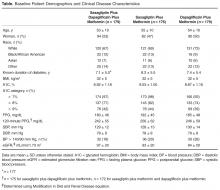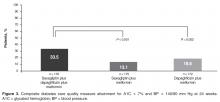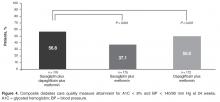Results
Patients
Patient disposition, baseline demographics, and disease characteristics have been previously published [15]. A total of 534 patients were randomized to saxagliptin plus dapagliflozin plus metformin (n = 179), saxagliptinplus metformin (n = 176), or dapagliflozin plus metformin (n = 179) and received ≥ 1 dose of study medication. Patient demographics and baseline disease characteristics were generally balanced across all 3 treatment groups (Table). Mean age across the 3 treatment groups was 54 years, and there was a generally equal distribution of men and women. The mean known duration of T2D across the 3 treatment groups was 7.6 years, and mean baseline A1C was 8.94%. At baseline, 93% to 98% of patients had A1C > 7%, 74% to 82% had A1C > 8%, and 39% to 44% had A1C > 9%. At baseline, 18% to 28% of patients had BP > 140/90 mm Hg.
Individual Quality Measures
A significantly greater proportion of patients attained A1C < 7% (good glycemic control) with the dual add-on of saxagliptin plus dapagliflozin to metformin (41.8%) compared with saxagliptin plus metformin (16.6%, P < 0.001; NNT 4, 95% confidence interval [CI], 3–6) or dapagliflozin plus metformin (23.1%, P < 0.001; NNT 5, 95% CI, 4–11; Figure 2). The data were similar when the analysis excluded patients with baseline A1C < 7% (proportions of patients: 40.8% vs 15.6% vs 21.1%; P < 0.001 for both; NNTs 4 [95% CI 3–6] and 5 [95% CI 3–10]).
The dual addition of saxagliptin plus dapagliflozin to metformin resulted in a significantly greater proportion of patients achieving A1C < 8.0% compared with saxagliptin plus metformin (71.2% vs 49.1%; P < 0.001; NNT 5 [95% CI 3–8]) or dapagliflozin plus metformin (60.1%; P = 0.033; NNT 9 [95% CI 5–85]; Figure 2). Similar results (proportions of patients: 66.4% vs 40.0% vs 51.9%; P ≤ 0.02; NNTs 4 [95% CI 3–7]) and 7 [95% CI 4–34]) were attained when the analysis excluded patients with baseline A1C < 8.0%.
Significantly fewer patients had A1C > 9% (a measure of poor glycemic control) with saxagliptin plus dapagliflozin plus metformin (12.4%) compared with saxagliptin plus metformin (22.3%; P = 0.017; NNT –10 [95% CI –50 to –6]; Figure 2). The proportion of patients with A1C > 9% was similar for both regimens that included dapagliflozin (12.4% vs 10.4%; P = 0.616).
No significant difference was observed among treatment groups in the proportion of patients with BP < 140/90 mm Hg (Figure 2). However, most patients had BP < 140/90 mm Hg (72%–82%) at baseline, which was generally maintained at week 24.
Composite Quality Measures
A significantly greater proportion of patients attained the composite of A1C < 7% and BP < 140/90 mm Hg with saxagliptin plus dapagliflozin plus metformin (33.5%) compared with saxagliptin plus metformin (13.1%; P < 0.001; NNT 5 [95% CI 4–9]) or dapagliflozin plus metformin (18.6%; P = 0.002; NNT 7 [95% CI 4–17]; Figure 3). Results were similar when patients already at these goals at baseline were excluded from the analysis (32.4% vs 12.1% vs 16.3%; P < 0.001 for both; NNTs 5 [95% CI 4–9] and 6 [95% CI 4–14]).
A significantly greater proportion of patients achieved the composite of A1C < 8% and BP < 140/90 mm Hg with saxagliptin plus dapagliflozin plus metformin compared with saxagliptin plus metformin (56.8% vs 37.1%; P < 0.001; NNT 5 [95% CI 3–11]). Although not statistically significant, a numerically greater proportion of patients achieved A1C < 8% and BP < 140/90 mmHg with saxagliptin plus dapagliflozin plus metformin compared with dapagliflozin plus metformin (56.8% vs 50.0%; P = 0.237; Figure 4). Results were similar when patients already at these goals at baseline were excluded from the analysis (55.9% vs 30.2% [P < 0.001] vs 42.6% [P = 0.025]; NNTs 4 [95% CI 3–7] and 8 [95% CI 4–55]).
Discussion
This post hoc analysis evaluated attainment of glycemic and BP quality measures for diabetes. A significantly greater proportion of patients achieved the individual quality measures of A1C < 7% and A1C < 8% with dual add-on saxagliptin plus dapagliflozin to metformin compared with single add-on saxagliptin or dapagliflozin to metformin after 24 weeks. Similar results were seen when the analysis excluded patients with A1C < 7% and < 8% at baseline. All measures of good glycemic control had clinically relevant NNTs ≤ 10 after 24 weeks with saxagliptin plus dapagliflozin plus metformin compared with saxagliptin or dapagliflozin plus metformin, regardless of baseline status. Very few patients experienced lackof improvement in glycemic control, evidenced by small proportions of patients with A1C > 9%.










